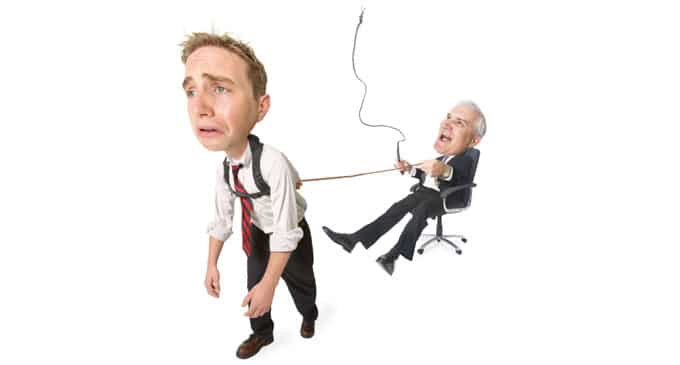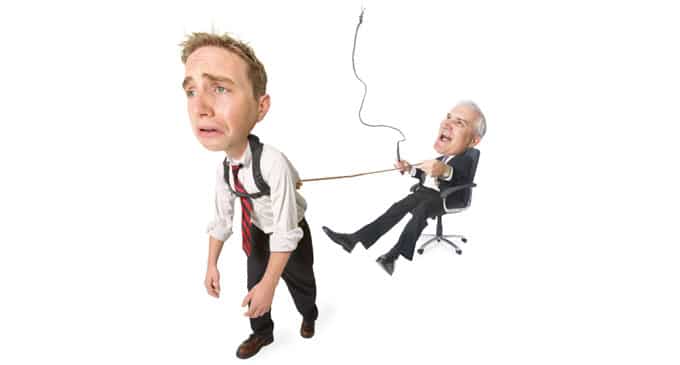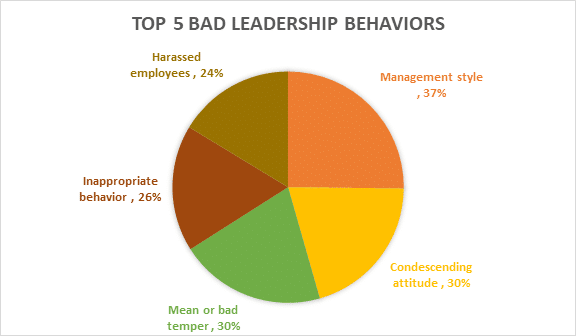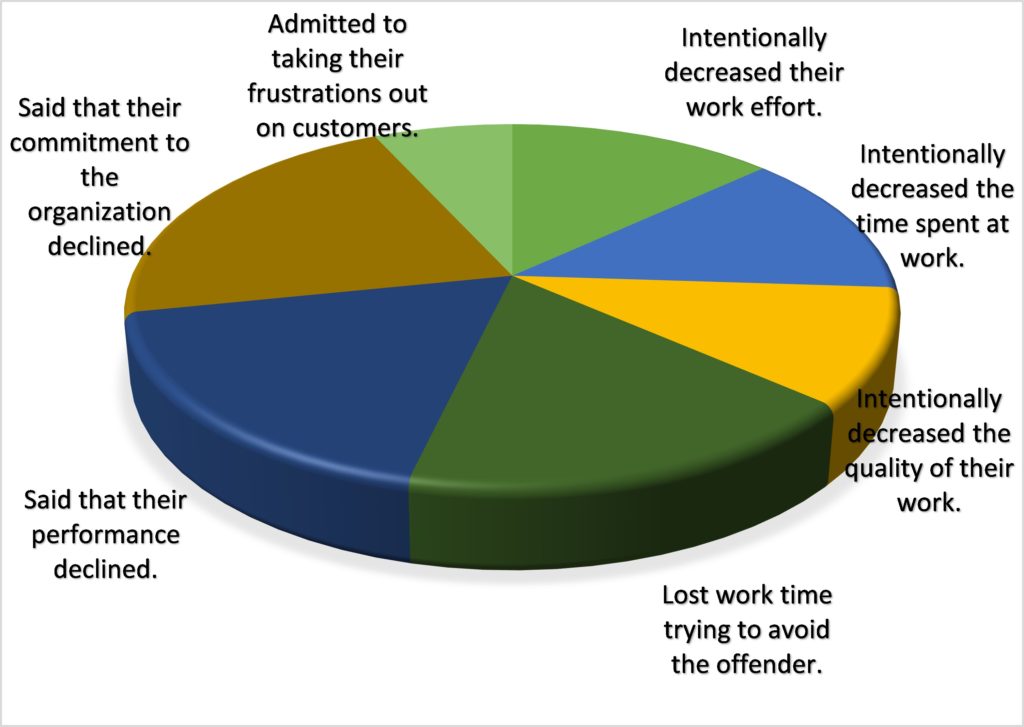
Poor Leadership Behaviors and its collateral damage
Poor leadership behaviors and bad leadership qualities cause severe collateral damage that is often hidden. Low employee engagement, high employee turnover, low productivity, and lack of discretionary effort are all symptoms of a single root cause – bad leadership behaviors. On the other hand, good leadership is one of the most important factors in determining the success of an organization. It directly affects employee motivation, productivity, and, most importantly, their performance. Tolerating bad leadership behaviors is costly for the organization. Helping leaders overcome their bad leadership behaviors significantly increases engagement, productivity, and profits.
Read: The importance of Leadership: Business impact of good and poor leadership
Most employees have encountered bad leadership behaviors
Over the span of our careers, most of us have had the unfortunate experience of working under a bad leader. What comes to mind when you think of bad leadership behaviors? What poor leadership behaviors have you seen in leaders you have worked for? What are bad leadership qualities, you know? A survey of 1000 employees by Bamboo HR lists the following behaviors that employees list as the top 10 bad leadership behaviors – along with the percentage of employees who considered such poor leadership behavior as a deal-breaker.

Top 10 bad leadership behaviors

Top 5 poor leadership behaviors that make employees QUIT
“People leave managers, not companies” is more true now than ever. An employee’s immediate boss wields more influence on how engaged and productive an employee will be. Manager impacts more than the culture, the salary, or any other factor that is within the organization’s control. Here are the top 5 bad leadership behaviors that are a deal-breaker. for employees

The style of management a leader follows
The management style practiced by a leader influences the behavior of his/her subordinates. Different teams, projects, and businesses need different management styles. A leader should consider the needs of his team members to manage them effectively. The wrong management style hurts everyone. Your perfect leadership style needs to align with your own skills, personality, and experience. It should also suit the culture of your organization and adhere to the needs of your team.
The condescending attitude of a manager
The issue of a condescending superior runs rampant in the business today.Condescension is usually a tone of voice where the words of a person are not the main issue. A leader communicates to his team members can make them feel as if they are being spoken down to, like a child or a brand new employee in an organization who does not understand the work. This feeling creates a sense of dissatisfaction among the employees.
Bad temper of a leader
I have learned that to become a good leader, one must rise above the passions of the moment and maintain a level head. Even in very tense situations, good leaders should be quick to listen and slow to anger. Leaders need to be patient with their team members to win their trust. Angry bosses are rarely effective, and it creates a negative influence on the subordinates.
Inappropriate behavior
At an organizational level, bad or inappropriate behavior can have a tangible impact on profitability. As a leader, one should avoid practicing any such behavior, resulting in employee dissatisfaction or hindering their performance. A leader should be concerned about his team members and make them feel valued at work.
Harassed employees
It is up to an organization’s leaders to promote an inclusive culture with a zero-tolerance policy against any type of harassment. Leaders should be aware of their team members’ problems or issues and should make sure that the employees do not face any kind of trouble or harassment while at work.
Poor leadership behaviors and bad leadership qualities are a serious drag to your bottom line.
Many surveys over the years have corroborated the fact that bad leadership behaviors lead to poor employee engagement, poor organizational culture, and low productivity. It’s safe to say that organizations’ money on leadership development is much more beneficial than the cost it has to incur because of poor leadership behaviors.
HBR Survey on the impact of poor leadership behaviors
Still, don’t you see bad leadership behaviors as a serious problem? Look at the numbers from a survey by Harvard Business Review. The employees who felt that their leaders were disrespectful to them admitted to the following behaviors.

- 48% intentionally decreased their work effort.
- 47% intentionally decreased the time spent at work.
- 38% intentionally decreased the quality of their work.
- 63% lost work time trying to avoid the offender.
- 66% said that their performance declined.
- 78% said that their commitment to the organization declined.
- 25% admitted to taking their frustrations out on customers.
Bad leadership behavior is detrimental to morale and productivity, but it also negatively affects the entire team.
Some obvious effects of poor leadership behaviors or bad leadership qualities are
- Lack of teamwork
- Silos within the organization
- Low morale
- High turnover
- Status quo vs. continuous change and improvement
- Low or no innovation
- Personal benefits trump team or organizational goals
In a VUCA (Volatile, Uncertain, Complex, and Ambiguous) business world, poor leadership is a recipe for disaster.
The cost of poor leadership behaviors is often hidden but they are a significant drag to engagement and performance.
DDI research found that a single poor leader’s cost to a company is $126,000 per year!
Read: What are the ego traps and Leadership Derailers leaders fall for?

How to identify and rectify poor leadership behaviors or bad leadership qualities?
Every individual and every leader has certain behaviors that help them be a good leader. On the other hand, every individual and every leader has certain behaviors that stop them from becoming better leaders. All leaders have their improvement areas. The question is – How do you tell a successful leader what they need to improve?
One of the best ways to identify bad leadership behaviors before becoming a serious drag on employee engagement and productivity is to foster a culture of honest feedback. As most employees are uncomfortable offering feedback to their leaders, the best way to start is by having anonymous 360-degree feedback of all leaders regularly – at least once a year. Once bad leadership behaviors are identified, give the leaders some coaching to address these behaviors. If there is no significant improvement in the leader’s bad behavior, it may be prudent to let the leader go. Sometimes, firing a single toxic leader is more than enough to improve the entire team’s morale!
An anonymous 360-degree assessment is the best way to make the leader aware of her improvement areas! 360-degree feedback aka multi-rater feedback is an anonymous survey of questions about the leader’s behavior at work. The leader’s team members – subordinates, peers, and boss(es) fill the survey anonymously. This ensures honest and accurate feedback.
Identify leaders’ poor leadership behaviors (and strengths)
As a leader moves up the career ladder, he/she gets lesser and lesser useful feedback. People are uncomfortable sharing any critical or constructive feedback to the leader’s face. In addition, rightly or wrongly, employees fear repercussions from the leader – if they shared honest feedback about the leader.
Hence the best way to identify bad leadership behaviors (or leadership improvement areas) is to conduct anonymous 360-degree feedback using a validated assessment.
Global Leadership Assessment (GLA360)
The GLA360 is a 360-degree feedback tool rooted in groundbreaking research conducted by Marshall Goldsmith (#1 Leadership Thinker and Executive Coach), involving CEOs of Fortune 100 companies, global thought leaders, and international business executives of organizations on 6 continents. The GLA360 articulates and measures the top 15 most pressing competencies for today’s global leader. It shows leaders the areas they need to develop to succeed in a competitive business environment.
To know more about 360-degree feedback and the GLA 360 degree assessment click on the following link.
Read: 360 degree feedback A complete guide with questionnaire
We offer the GLA 360 assessments starting from $99. Click the image below to find out more.
Knowing vs. doing
The 360-degree feedback makes the leader of how others perceive her. It helps her know her strengths and improvement areas. Is that sufficient? Knowing is only the first step. Converting the knowing into doing is the key to change.
Four steps to improving poor leadership behaviors
- Awareness: 360-degree feedback makes the leader aware of how others perceive him/her and the strengths and improvement areas
- Acceptance: Telling successful leaders that they need to improve in some areas is difficult. Successful leaders may simply reject the feedback. Or they may justify it by saying that they get the job done and deliver results! Convincing the leader to accept the feedback is an art best handled by an experienced coach. An experienced coach helps the leader see the benefit in accepting the feedback and making efforts towards improvement.
- Consistent Action: If nothing changes, then nothing changes! Awareness and acceptance are necessary. But they are not sufficient to change the behavior. An action plan and implementation of the plan are essential for lasting change. Progressive organizations help leaders take consistent action with the help of an executive coach.
- Achievement: Awareness, acceptance and consistent action lead to achievement. This achievement is improved behaviors at work, as anonymously rated by the leader’s own team members.
Supporting the leader with executive coaching:
Is behavior change easy or hard?
I often ask this question to my potential leadership coaching clients. On a scale of 1 to 10, how easy or hard it is to change the behavior of a successful adult? I will pose the same question to you? Then I ask – how hard or easy it is to change the behavior of a successful adult. What number did you pick? Usually, the answer ranges from 8 to 10, meaning that it is very difficult to change the long-ingrained behaviors of successful leaders.
Losing weight is simple but not easy!
Imagine that you have a goal of losing weight and getting fit. Can you achieve this goal on your own? Of course, you can. Losing weight is simple! Consume lesser calories, and expend more calories on a daily basis. One of the most popular goals around the new year is to lose weight or get fit. But a few people go beyond the initial enthusiasm. By Valentine’s day, the goal is long forgotten and things go back to the status quo. Losing weight is simple, but not easy!
Hiring a personal trainer
Instead of a do-it-yourself approach to weight loss, what would happen if you hired a personal trainer? Would your chances of success go up? Of course, they would! Studies have shown that hiring a personal trainer improves the chance of weight loss success by a whopping 1100%. You are 11 times more likely to lose weight with the help of a personal trainer, vs. a do-it-yourself approach.
An executive coach is a personal trainer for leadership development
A skilled executive coach takes the leader through the steps of awareness, acceptance, and consistent action. Without the help of an executive coach, behavior change is possible but very difficult. An executive coach is like a personal trainer for overcoming bad leadership behaviors and helping the leader become a more effective leader. A leader may be able to reign in their poor leadership behaviors on their own. But a leadership coach improves the chances exponentially.
NAL Triple Advantage Leadership Coaching
We offer our New Age Leadership Triple advantage coaching that delivers guaranteed and measurable leadership growth. It is based on a stakeholder-centered coaching process with a 95% effectiveness rate (in a study or 11000 leaders on 4 continents). It is used by companies ranging from startups to 150 of the Fortune 500 companies to develop their leaders.
Here are some of the salient benefits of NAL Triple Advantage Leadership Coaching
Time and resource-efficient: The leader does not have to leave work to attend training programs. We go to the leader and her team. And it only takes 1.5 hours per month. The rest of the time, the leader is working to implement with her team.
Separate and customized improvement areas for each leader: Every leader is different. One size fits all approach doesn’t work. Individual development areas for each leader aligned to the business strategy.
Involves entire team: Unlike most leadership programs, NAL Triple Advantage Leadership Coaching involves the leader’s entire team, and it has a cascading effect – increasing the team effectiveness and improving organizational culture.
The leader becomes the coach: for continuous improvement for leaders themselves and their teams. It is like kaizen for your leadership development.
Cost-Effective: Our entire one-year coaching engagement often costs less than sending the leader to a short-duration leadership program at any reputed B school.
Guaranteed and measurable leadership growth: as assessed – not by us – but anonymously rated by the leader’s own team members.
Pay us only after we deliver results!: We work with many of our clients on a pay for results basis. What does it mean? If the leaders don’t improve, you simply don’t have to pay us.
Schedule an exploratory 15-minute conversation with our leadership adviser today
Click the button below.
Read: Is your leadership development effective? Or is the money going down the drain?
References
https://www.bamboohr.com/resources/infographics/bad-boss/
https://www.inc.com/marcel-schwantes/a-new-survey-finds-that-63-percent-of-employees-ab.html
Book – A leader’s gift – How to earn the right to be followed
Watch the Video on the Hidden costs of poor leadership.

